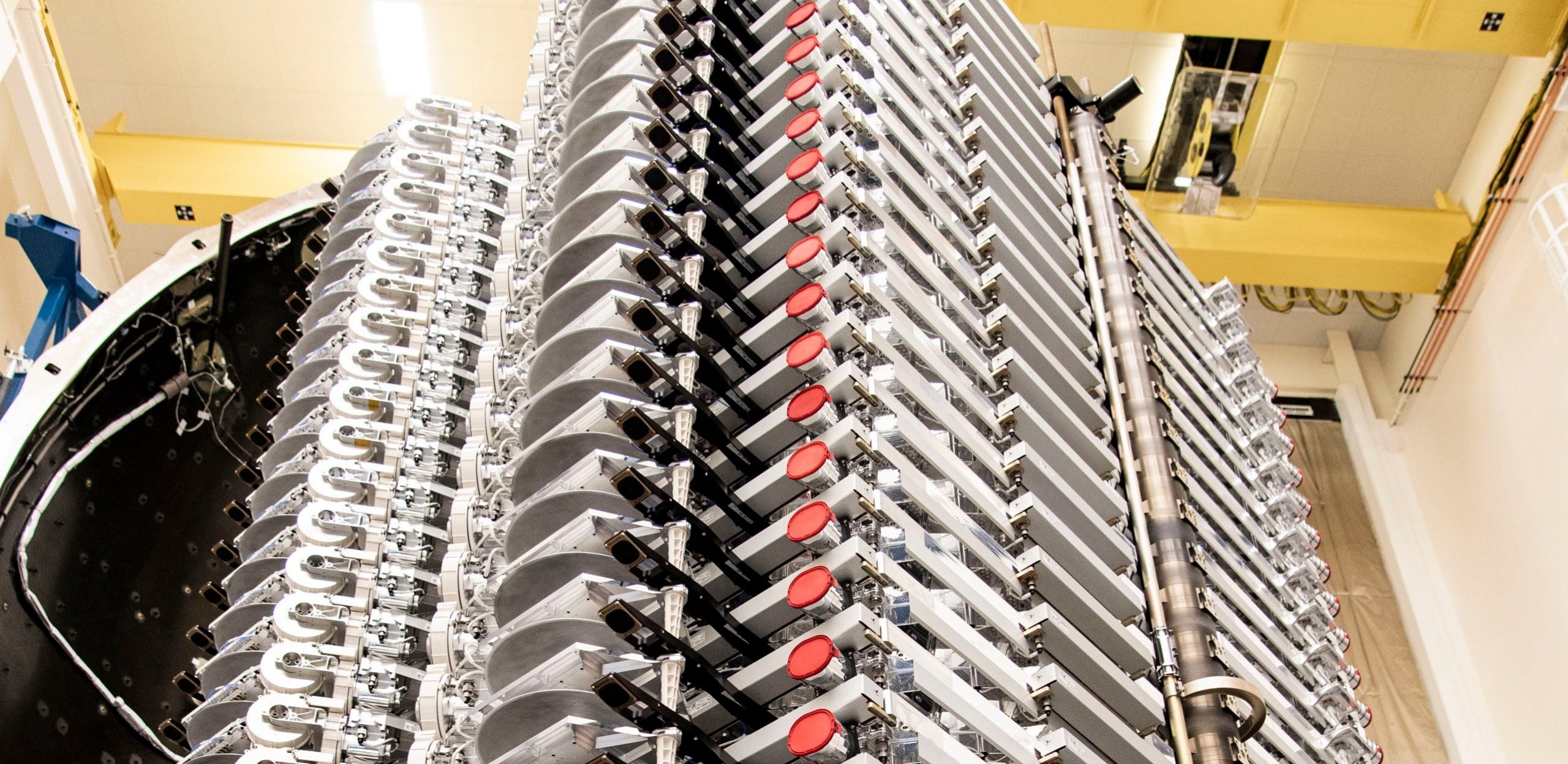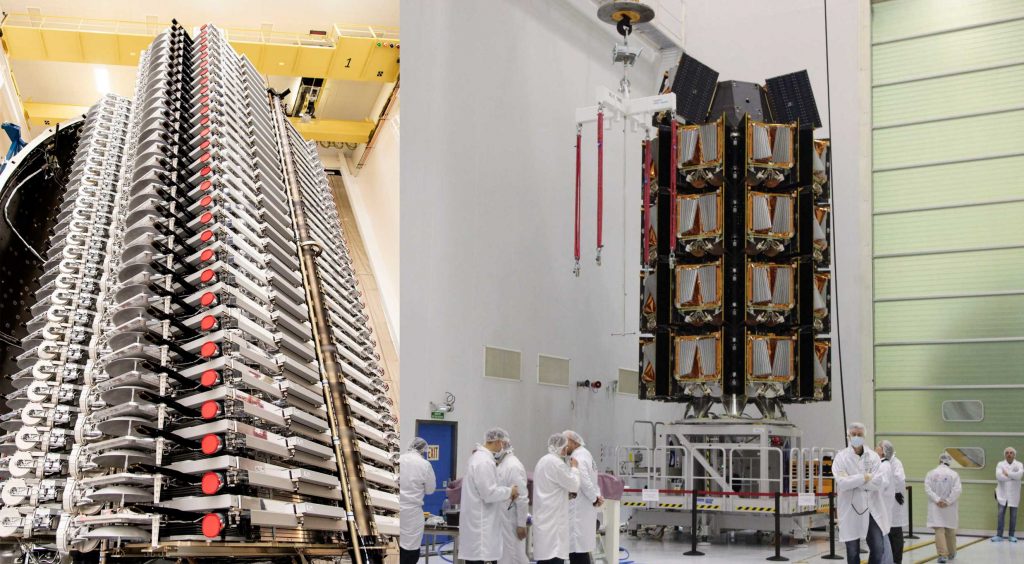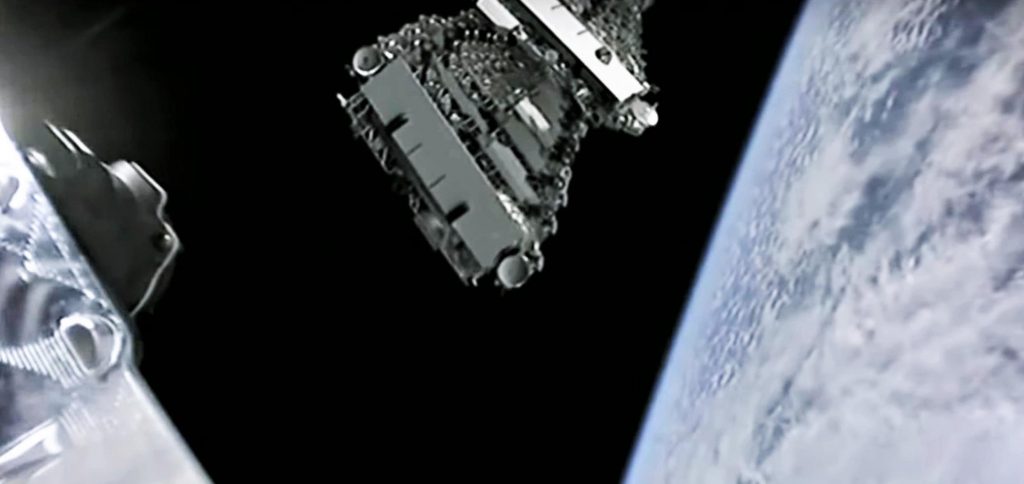

News
SpaceX Starlink factory building satellites four times faster than closest competitor
An executive says that SpaceX’s Seattle-based Starlink factory is building satellites up to four times faster than OneWeb, the company’s closest competitor in the new low Earth orbit (LEO) internet space race.
Speaking at the SATELLITE 2020 Conference on March 9th, Jonathan Hofeller – VP of Starlink and Sales – revealed SpaceX’s extraordinary Starlink production rate just days before the company’s sixth planned 60-satellite launch. Now two days away from liftoff with Falcon 9 and its satellite stack already vertical at the launch pad, SpaceX will likely end the week with some 350 operational satellites in orbit – around twice as many as any other public or private constellation in history.
While SpaceX will have soon attempted five 60-satellite Starlink launches in four months, CEO Elon Musk recently revealed that the company is still building spacecraft faster than it can launch them. At a reported production rate of six satellites per day, that news is now incredibly unsurprising given that it means SpaceX could theoretically build the world’s second-largest satellite constellation (excluding Starlink) in a single month. To be clear, though, the company has created one of the best possible problems the Starlink program could have.

First revealed in late 2019 and reiterated in recent months, SpaceX executives have consistently noted that the company plans to attempt some 20-24 dedicated Starlink launches in 2020 alone. As previously noted on Teslarati, 20-24 launches could put enough Starlink satellites in orbit for SpaceX to realistically begin serving customers almost anywhere on Earth.
“In recent months, SpaceX has indicated that Starlink will need at least 24 dedicated launches – 1440 satellites – to achieve uninterrupted global coverage, while as few as six launches (300 satellites) could enable service for customers in the northern US and southern Canada.
COO and President Gwynne Shotwell believes SpaceX can begin serving customers as early as mid-2020, ultimately maturing into an experienced internet service provider (ISP) in 2021. With almost 120 satellites already in orbit, if SpaceX can manage an average of 1.5 to 2 Starlink launches per month in 2020, the broadband internet constellation should have near-global coverage by the end of the year.”
Teslarati.com — December 20th, 2019

Two and a half months into 2020, it’s entirely possible that SpaceX already has several launches worth of Starlink satellites waiting for their Falcon rockets. Weather and hardware-related delays have impacted each of the three 2020 Starlink launches SpaceX has completed thus far, pushing its internal manifest back by at least several weeks. SpaceX could be strategically slowing work at its factory based on predictions of rocket availability in the next few months, avoiding a massive stockpile of Starlink satellites. Still, it’s just as likely that its Seattle HQ has been churning out several satellites per day for weeks or even months. Even if SpaceX has only averaged four satellites per day over the last three months, it would likely have a backlog of 4+ launches (~240 satellites).
Bigger, cheaper, faster

Compared to OneWeb, SpaceX Starlink satellites thus weigh 75% more, offer at least 50% more bandwidth for internet services, can be manufactured for less than half the cost in a quarter of the time, and likely cost – per satellite – at least three times less to launch. These are the fundamental, unavoidable benefits of SpaceX’s preferred strategy of vertical integration writ large. End-product quality and functionality held equal, it’s numerically impossible for a more traditional company like OneWeb to compete head-to-head with a vertically-integrated competitor like SpaceX.
Thankfully, though, the supply for LEO-based internet services is currently so small – and the demand so large – that OneWeb will almost certainly be able to find a niche and survive. For now, the fact remains that SpaceX is all but guaranteed to continue building and launching far more satellites than OneWeb — all for a dramatically lower cost.
Check out Teslarati’s Marketplace! We offer Tesla accessories, including for the Tesla Cybertruck and Tesla Model 3.

Elon Musk
Tesla’s Elon Musk: 10 billion miles needed for safe Unsupervised FSD
As per the CEO, roughly 10 billion miles of training data are required due to reality’s “super long tail of complexity.”

Tesla CEO Elon Musk has provided an updated estimate for the training data needed to achieve truly safe unsupervised Full Self-Driving (FSD).
As per the CEO, roughly 10 billion miles of training data are required due to reality’s “super long tail of complexity.”
10 billion miles of training data
Musk comment came as a reply to Apple and Rivian alum Paul Beisel, who posted an analysis on X about the gap between tech demonstrations and real-world products. In his post, Beisel highlighted Tesla’s data-driven lead in autonomy, and he also argued that it would not be easy for rivals to become a legitimate competitor to FSD quickly.
“The notion that someone can ‘catch up’ to this problem primarily through simulation and limited on-road exposure strikes me as deeply naive. This is not a demo problem. It is a scale, data, and iteration problem— and Tesla is already far, far down that road while others are just getting started,” Beisel wrote.
Musk responded to Beisel’s post, stating that “Roughly 10 billion miles of training data is needed to achieve safe unsupervised self-driving. Reality has a super long tail of complexity.” This is quite interesting considering that in his Master Plan Part Deux, Elon Musk estimated that worldwide regulatory approval for autonomous driving would require around 6 billion miles.
FSD’s total training miles
As 2025 came to a close, Tesla community members observed that FSD was already nearing 7 billion miles driven, with over 2.5 billion miles being from inner city roads. The 7-billion-mile mark was passed just a few days later. This suggests that Tesla is likely the company today with the most training data for its autonomous driving program.
The difficulties of achieving autonomy were referenced by Elon Musk recently, when he commented on Nvidia’s Alpamayo program. As per Musk, “they will find that it’s easy to get to 99% and then super hard to solve the long tail of the distribution.” These sentiments were echoed by Tesla VP for AI software Ashok Elluswamy, who also noted on X that “the long tail is sooo long, that most people can’t grasp it.”
News
Tesla earns top honors at MotorTrend’s SDV Innovator Awards
MotorTrend’s SDV Awards were presented during CES 2026 in Las Vegas.

Tesla emerged as one of the most recognized automakers at MotorTrend’s 2026 Software-Defined Vehicle (SDV) Innovator Awards.
As could be seen in a press release from the publication, two key Tesla employees were honored for their work on AI, autonomy, and vehicle software. MotorTrend’s SDV Awards were presented during CES 2026 in Las Vegas.
Tesla leaders and engineers recognized
The fourth annual SDV Innovator Awards celebrate pioneers and experts who are pushing the automotive industry deeper into software-driven development. Among the most notable honorees for this year was Ashok Elluswamy, Tesla’s Vice President of AI Software, who received a Pioneer Award for his role in advancing artificial intelligence and autonomy across the company’s vehicle lineup.
Tesla also secured recognition in the Expert category, with Lawson Fulton, a staff Autopilot machine learning engineer, honored for his contributions to Tesla’s driver-assistance and autonomous systems.
Tesla’s software-first strategy
While automakers like General Motors, Ford, and Rivian also received recognition, Tesla’s multiple awards stood out given the company’s outsized role in popularizing software-defined vehicles over the past decade. From frequent OTA updates to its data-driven approach to autonomy, Tesla has consistently treated vehicles as evolving software platforms rather than static products.
This has made Tesla’s vehicles very unique in their respective sectors, as they are arguably the only cars that objectively get better over time. This is especially true for vehicles that are loaded with the company’s Full Self-Driving system, which are getting progressively more intelligent and autonomous over time. The majority of Tesla’s updates to its vehicles are free as well, which is very much appreciated by customers worldwide.
Elon Musk
Judge clears path for Elon Musk’s OpenAI lawsuit to go before a jury
The decision maintains Musk’s claims that OpenAI’s shift toward a for-profit structure violated early assurances made to him as a co-founder.

A U.S. judge has ruled that Elon Musk’s lawsuit accusing OpenAI of abandoning its founding nonprofit mission can proceed to a jury trial.
The decision maintains Musk’s claims that OpenAI’s shift toward a for-profit structure violated early assurances made to him as a co-founder. These claims are directly opposed by OpenAI.
Judge says disputed facts warrant a trial
At a hearing in Oakland, U.S. District Judge Yvonne Gonzalez Rogers stated that there was “plenty of evidence” suggesting that OpenAI leaders had promised that the organization’s original nonprofit structure would be maintained. She ruled that those disputed facts should be evaluated by a jury at a trial in March rather than decided by the court at this stage, as noted in a Reuters report.
Musk helped co-found OpenAI in 2015 but left the organization in 2018. In his lawsuit, he argued that he contributed roughly $38 million, or about 60% of OpenAI’s early funding, based on assurances that the company would remain a nonprofit dedicated to the public benefit. He is seeking unspecified monetary damages tied to what he describes as “ill-gotten gains.”
OpenAI, however, has repeatedly rejected Musk’s allegations. The company has stated that Musk’s claims were baseless and part of a pattern of harassment.
Rivalries and Microsoft ties
The case unfolds against the backdrop of intensifying competition in generative artificial intelligence. Musk now runs xAI, whose Grok chatbot competes directly with OpenAI’s flagship ChatGPT. OpenAI has argued that Musk is a frustrated commercial rival who is simply attempting to slow down a market leader.
The lawsuit also names Microsoft as a defendant, citing its multibillion-dollar partnerships with OpenAI. Microsoft has urged the court to dismiss the claims against it, arguing there is no evidence it aided or abetted any alleged misconduct. Lawyers for OpenAI have also pushed for the case to be thrown out, claiming that Musk failed to show sufficient factual basis for claims such as fraud and breach of contract.
Judge Gonzalez Rogers, however, declined to end the case at this stage, noting that a jury would also need to consider whether Musk filed the lawsuit within the applicable statute of limitations. Still, the dispute between Elon Musk and OpenAI is now headed for a high-profile jury trial in the coming months.








